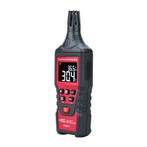Anemometer Functional Characteristics Anemometer General Data
Anemometer, as the name implies, is an instrument for measuring air velocity. There are many types of it, and the most commonly used one in meteorological stations is the wind cup anemometer, which consists of three parabolic cone empty cups fixed on the bracket at 120° to each other to form the sensing part, and the concave surfaces of the empty cups are all in one direction. The whole induction part is installed on a vertical rotating shaft, and under the action of wind force, the wind cup rotates around the shaft at a speed proportional to the wind speed. Another rotary anemometer is the propeller anemometer, which consists of a three-blade or four-blade propeller as the sensing part, which is installed on the front end of a wind vane so that it is always aligned with the direction of the wind. The blades rotate around a horizontal axis at a speed proportional to the wind speed.
Features
Wind speed: m/s, ft/min, Knots, km/hr, mph
Air volume (CFM, CMM): instantaneous value, average value and 2/3 maximum value method measurement
LCD large screen display background light display function
Temperature measurement ℃/℉ switching (only for FA4202T/A4201T)
RS-232 interface (A4202R)
Maximum, minimum, data hold; 2,000 data records
Easy to operate; convenient to use℉
Anemometer General Data
Battery: 9V square laminated battery
Display: 2×4 four-digit dual display LCD
Bearings: precision high-speed ball bearings or artificial gemstones
Temperature (FA4202T/A4201T)
Operating temperature: 0℃~80℃(instrument); 0℃~60℃(fan)
Ambient humidity: <80[%]R.H
Storage temperature: -40℃~60℃; current consumption: about 3mA°
Instrument size: 76.0×168.0×26.2mm;
Fan size: Φ71.0×218.0 (handle length) mm; standard configuration: carrying case, instruction manual, 9V battery, software (FA4202R).
technical indicators
Application field
Anemometers are widely used and can be used flexibly in all fields. They are widely used in electric power, steel, petrochemical, energy-saving and other industries. There are other applications in the Beijing Olympic Games, such as sailing competitions, rowing competitions, field shooting competitions, etc. Need to use an anemometer to measure. The current anemometer is relatively advanced, in addition to measuring wind speed, it can also measure wind temperature and air volume. There are many industries that need to use anemometers, recommended industries: fishing industry, various fan manufacturing industries, industries that require ventilation and exhaust systems, etc.
Anemometer Different seasons and different geographical conditions will cause the wind direction in the atmosphere to change constantly. For example, the wind direction of the seaside is different day and night, and there are different monsoons in winter and summer. Studying wind direction can help us predict and study climate change. Studying wind direction requires the use of an anemometer. The design of the anemometer is mostly in the shape of an arrow, but also in the shape of an animal, like a rooster. The fletch part of the anemometer will rotate with the wind direction. The anemometer needs to be installed in a place where there are no buildings or trees that obstruct the movement of the wind. Purpose and scope of application QDp series hot bulb electric anemometer is used in heating, ventilation, air conditioning, meteorology, agriculture, refrigeration and drying, labor hygiene investigation, etc. It can be used when it is necessary to measure the airflow velocity indoors and outdoors or models. It is a basic instrument for measuring low wind speed. In 1987, the product was appraised as a high-quality product in Beijing by the Beijing Municipal Economic Commission. Working principle The instrument consists of two parts, a thermal bulb sensor and a measuring instrument. The head of the sensor has a tiny glass sphere with a nichrome wire coil that heats the glass and two thermocouples connected in series. The cold end of the thermocouple is connected to the phosphor bronze pillar and is directly exposed to the air flow. When a certain size of current passes through the heating coil, the glass ball is heated to a certain temperature. This temperature is related to the speed of the air flow. The temperature is higher when the flow rate is small high, and vice versa.






